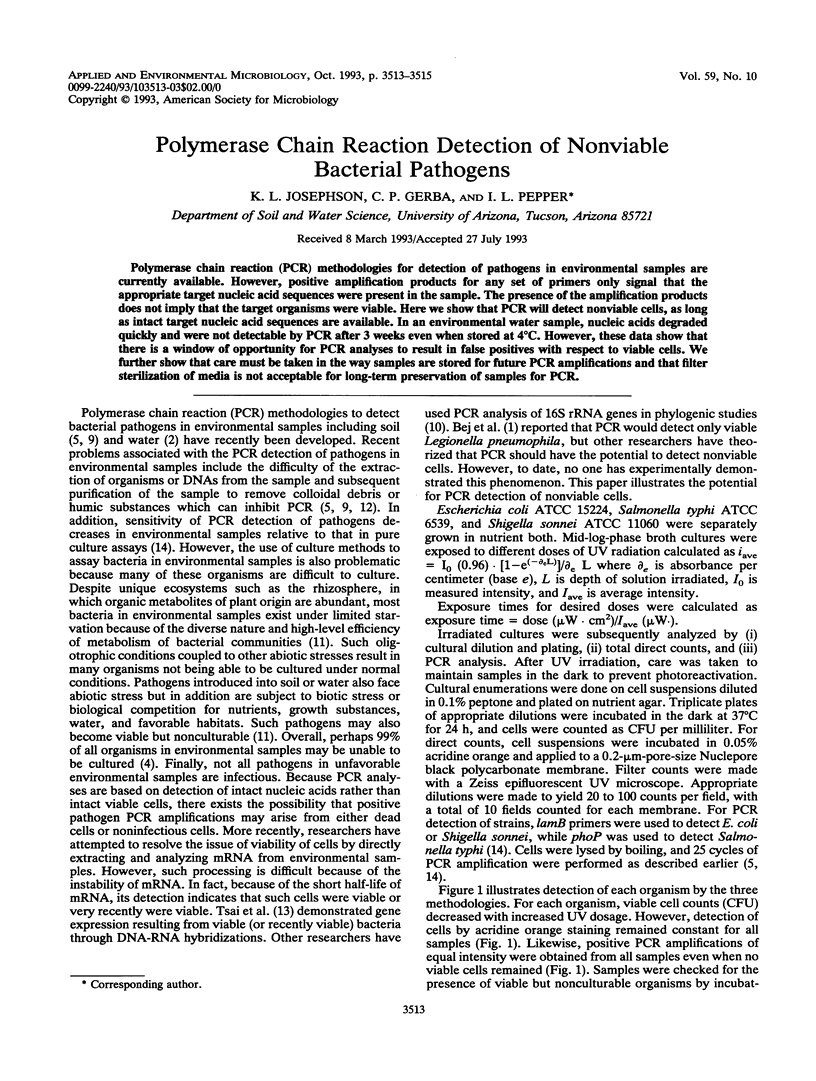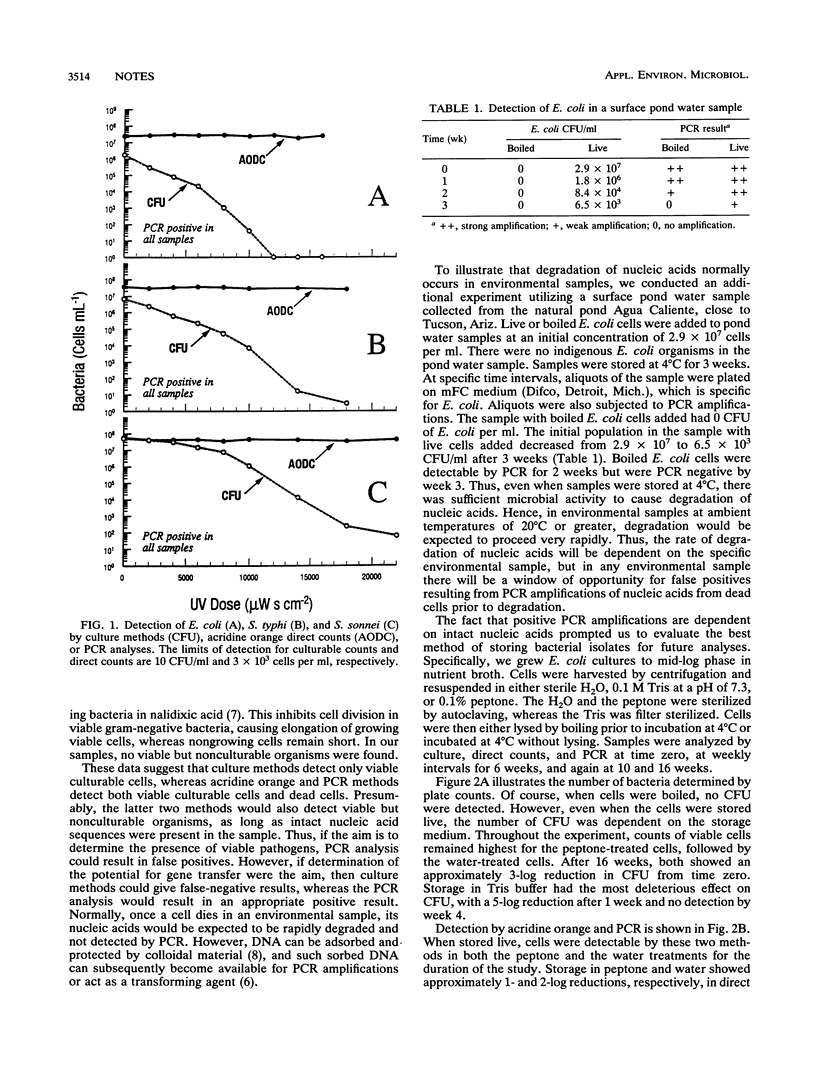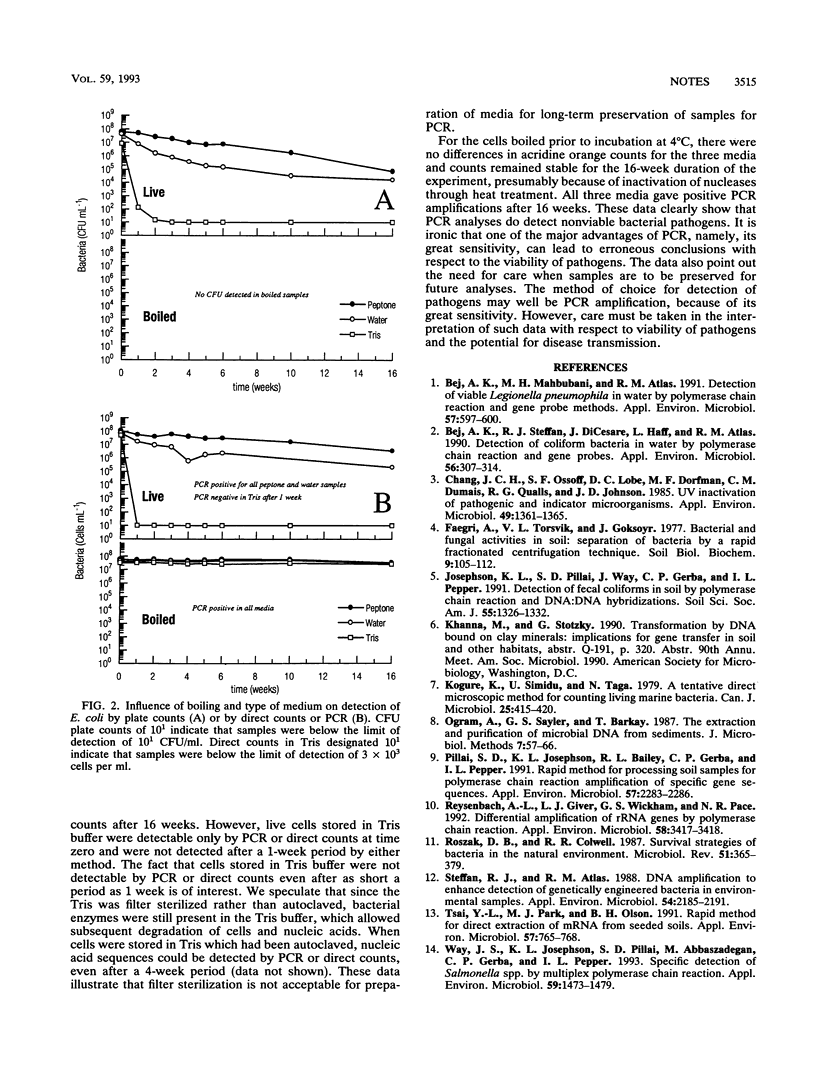Abstract
Polymerase chain reaction (PCR) methodologies for detection of pathogens in environmental samples are currently available. However, positive amplification products for any set of primers only signal that the appropriate target nucleic acid sequences were present in the sample. The presence of the amplification products does not imply that the target organisms were viable. Here we show that PCR will detect nonviable cells, as long as intact target nucleic acid sequences are available. In an environmental water sample, nucleic acids degraded quickly and were not detectable by PCR after 3 weeks even when stored at 4 degrees C. However, these data show that there is a window of opportunity for PCR analyses to result in false positives with respect to viable cells. We further show that care must be taken in the way samples are stored for future PCR amplifications and that filter sterilization of media is not acceptable for long-term preservation of samples for PCR.
Full text
PDF


Selected References
These references are in PubMed. This may not be the complete list of references from this article.
- Bej A. K., Mahbubani M. H., Atlas R. M. Detection of viable Legionella pneumophila in water by polymerase chain reaction and gene probe methods. Appl Environ Microbiol. 1991 Feb;57(2):597–600. doi: 10.1128/aem.57.2.597-600.1991. [DOI] [PMC free article] [PubMed] [Google Scholar]
- Bej A. K., Steffan R. J., DiCesare J., Haff L., Atlas R. M. Detection of coliform bacteria in water by polymerase chain reaction and gene probes. Appl Environ Microbiol. 1990 Feb;56(2):307–314. doi: 10.1128/aem.56.2.307-314.1990. [DOI] [PMC free article] [PubMed] [Google Scholar]
- Chang J. C., Ossoff S. F., Lobe D. C., Dorfman M. H., Dumais C. M., Qualls R. G., Johnson J. D. UV inactivation of pathogenic and indicator microorganisms. Appl Environ Microbiol. 1985 Jun;49(6):1361–1365. doi: 10.1128/aem.49.6.1361-1365.1985. [DOI] [PMC free article] [PubMed] [Google Scholar]
- Kogure K., Simidu U., Taga N. A tentative direct microscopic method for counting living marine bacteria. Can J Microbiol. 1979 Mar;25(3):415–420. doi: 10.1139/m79-063. [DOI] [PubMed] [Google Scholar]
- Pillai S. D., Josephson K. L., Bailey R. L., Gerba C. P., Pepper I. L. Rapid method for processing soil samples for polymerase chain reaction amplification of specific gene sequences. Appl Environ Microbiol. 1991 Aug;57(8):2283–2286. doi: 10.1128/aem.57.8.2283-2286.1991. [DOI] [PMC free article] [PubMed] [Google Scholar]
- Reysenbach A. L., Giver L. J., Wickham G. S., Pace N. R. Differential amplification of rRNA genes by polymerase chain reaction. Appl Environ Microbiol. 1992 Oct;58(10):3417–3418. doi: 10.1128/aem.58.10.3417-3418.1992. [DOI] [PMC free article] [PubMed] [Google Scholar]
- Roszak D. B., Colwell R. R. Survival strategies of bacteria in the natural environment. Microbiol Rev. 1987 Sep;51(3):365–379. doi: 10.1128/mr.51.3.365-379.1987. [DOI] [PMC free article] [PubMed] [Google Scholar]
- Steffan R. J., Atlas R. M. DNA amplification to enhance detection of genetically engineered bacteria in environmental samples. Appl Environ Microbiol. 1988 Sep;54(9):2185–2191. doi: 10.1128/aem.54.9.2185-2191.1988. [DOI] [PMC free article] [PubMed] [Google Scholar]
- Tsai Y. L., Park M. J., Olson B. H. Rapid method for direct extraction of mRNA from seeded soils. Appl Environ Microbiol. 1991 Mar;57(3):765–768. doi: 10.1128/aem.57.3.765-768.1991. [DOI] [PMC free article] [PubMed] [Google Scholar]
- Way J. S., Josephson K. L., Pillai S. D., Abbaszadegan M., Gerba C. P., Pepper I. L. Specific detection of Salmonella spp. by multiplex polymerase chain reaction. Appl Environ Microbiol. 1993 May;59(5):1473–1479. doi: 10.1128/aem.59.5.1473-1479.1993. [DOI] [PMC free article] [PubMed] [Google Scholar]


